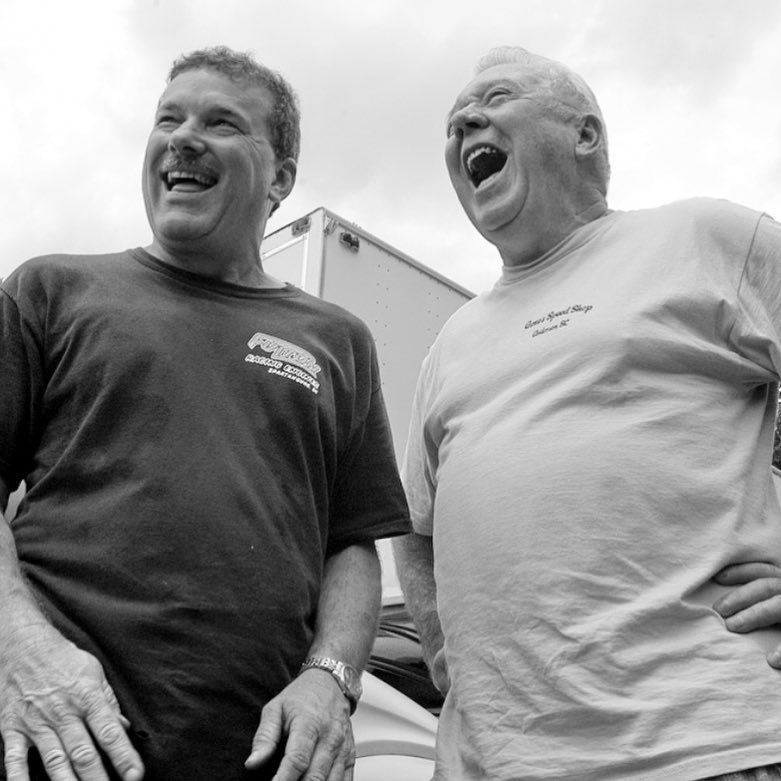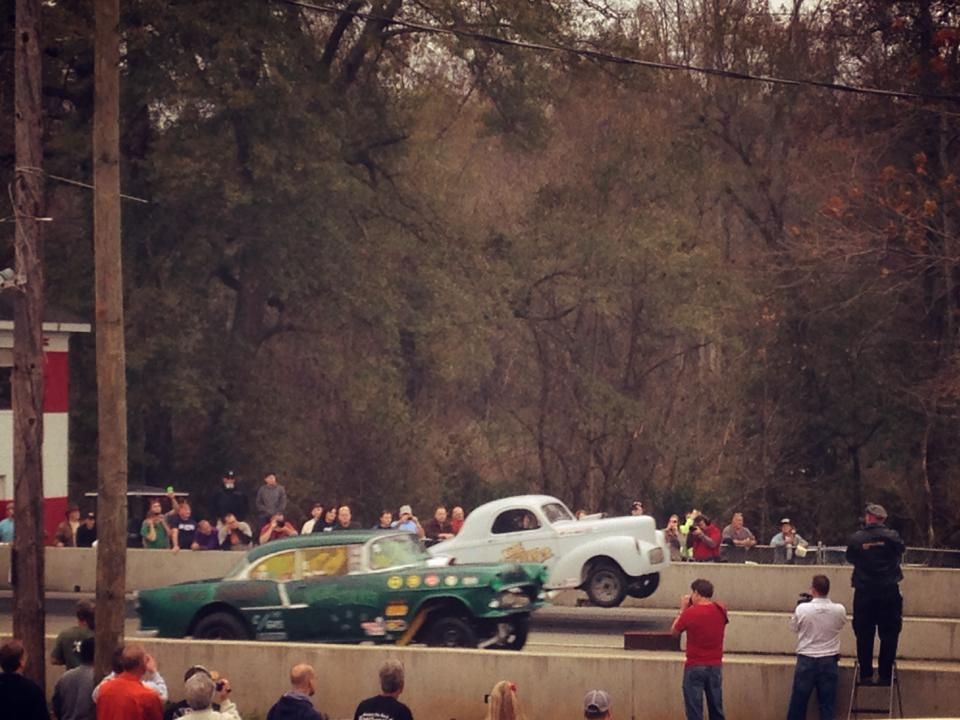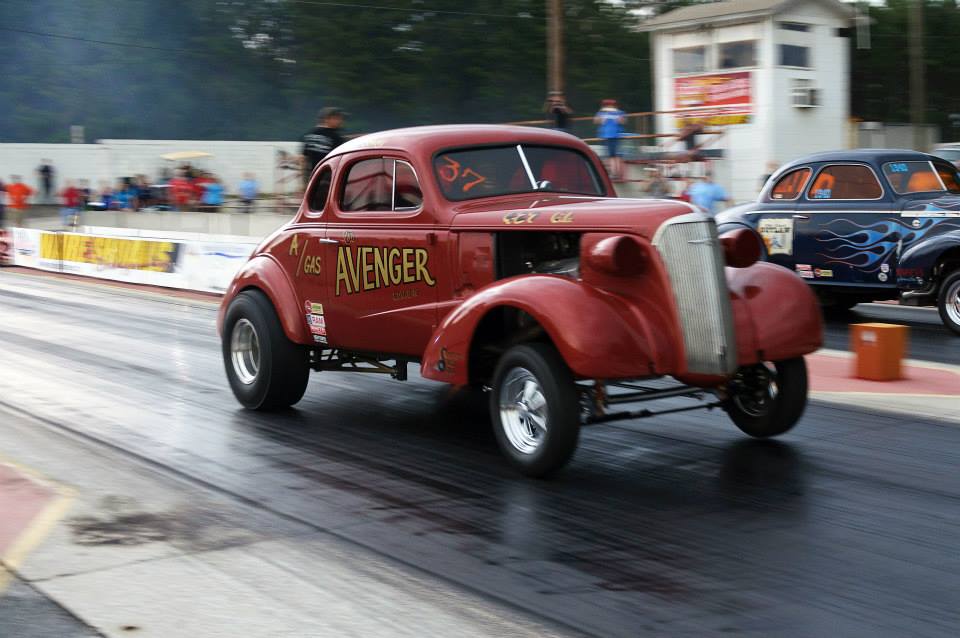STOTT’S SOUTHEAST GASSERS SERIES HAS STOOD THE TEST OF TIME


Five years ago Quain Stott had a brilliant plan.
The former IHRA Pro Modified world champion would build a series of race cars the wrong way on purpose. Today, Stott will tell you, depending on the type of day he’s experienced, it was one of the wisest decisions he’s ever made.
Stott’s race cars are period correct Gassers from the mid-1960s and they are a hit in the Carolinas, a part of the country where doorslammer racing is as common as Duke’s mayonnaise and tomato sandwiches.
Stott says it was peer pressure which led him down this road of creating a period correct Gasser series known as the Southeast Gassers.
In 2010, local racer Greg Porter had found and purchased an authentic 1955 Chevy Gasser. The basket case bowtie was then prepared somewhat for the drag strip, and as most any drag racer will attest, having a race car with nobody else to race it against is no fun.
Stott, for the most part, was already retired from Pro Modified and his pre-Gasser series personality made him an easy target for Porter to pick a fight; a fight on the strip, of course.
Porter challenged Stott on a regular basis to a match race, but there was a problem. Stott’s street-driven ’55 Chevy was no match and his supercharged Pro Modified was nowhere close to a fair fight.
Stott decided to build a Gasser, the likes of which he watched run as a nine year old at Spartanburg Dragway and other places close to his Tryon, North Carolina home.
Stott built a 1941 Willy, put a straight-axle out front, a small block Chevy between the fenders and a clutch-assist four-speed in the tunnel. He called the car the Executioner and rolled to the Greer Dragway starting line with the car painted in primer on purpose for the much ballyhooed match race.
As Stott looked over at Porter for their first run, he noticed a mob of admiring race fans gawking over these cars which looked every bit like a pair of true Gassers from 1967.

Thus began a twice per year tradition at Greer Dragway, and select other parts of the southeast. What started with two cars match racing has now evolved into as many as 60 cars built under the strictest period correct rules of any nostalgia series.
The Southeast Gasser Series kicks off its fifth season this weekend in Greer, South Carolina.
“When we go into a track 99% of the time it’s just our show,” Stott explained. “Greer for example, there’s no other show there; only the Southeast Gassers. Every person that came through the gate came to see us. This past fall race at Greer, we set the fan attendance record from all the way back in 1981. We didn’t lack but 60-something spectators setting it back to the opening day back in 1958.”
Saturday’s event is the first of a nine-race schedule which travels as far as Byron, Illinois with stops in Knoxville, Tenn. Montgomery, Ala., and Chattanooga, Tenn., to name a few.
This weekend’s event has as many as 42 pre-entered with cars running either A/Gas or C/Gas. Stott opened up what was once a “class show” in spirit to full-fledged tech and scale-verified class assignment.
That’s a far cry from the first event which only attracted only six cars.
Why is there no B/Gas class? Stott explains, “I started A/Gas and its 5 ½ pounds per cubic inch. C-Gas is 8 pounds per cubic inch. I’ve left a spot open for a B/Gas later at 7 pounds per cubic inch. The reason I went ahead and jumped to C is because there are more cars that fit that eight pound deal. If I made it B/Gas then they were going to have to go cut their cars up to get some weight off to be racing in B/Gas. Somebody that is in-between can simply add weight to run C/Gas. When we get an over-abundance of cars then I’ll come in and do a B-Gas and have three classes.”
Stott says the expansion is a means of trying to grow the series into a self-sufficient show for the smaller tracks who have been priced out of the match race scene. Tickets cost $15 for what he believes is the one true show which takes them back to the 1960s.
“A lot of the other ones are starting to catch up but what we’re having trouble overcoming is the bad name that the gassers have got because of those groups that aren’t truly period correct,” explained Stott. “They’re advertising a Gasser show and then when the fans get there they aren’t true Gassers, half of them are running on alcohol and with automatic transmissions. If you’re going to be a Gasser, shouldn’t you at least run gasoline?”

Stott has been so adamant about the authenticity of Gassers he allows to run that it’s even cost him friendships and enough headaches, he’s wondered why he should continue to chase his first childhood drag racing love.
“I’m about $70,000 in the hole right now and it’s obviously going to take a sponsor to pull it out,” admitted Stott. “It’s costing me about $15,000 per year on the average.
How does one keep hemorrhaging money and still grow?
“I guess I’ve got to be the most dedicated person in the world,” explained Stott. “I’m not a rich man. I’m comfortable but I’m not rich. I work my ass off. There’s somebody in the world right now that loves this as much as I do that’s going to come along and say that they want to help keep it going.
“Take me for example, if somebody else had started it and they were doing it exactly the way that I’m doing it, I wouldn’t think anything about giving them $10,000 a year because then I could go race and have a good time and still be spending less money than I am now.
“I’m getting all kinds of offers and people are calling me but one of the problems with us finding sponsorship is that I’m so particular about logos on the cars.”
Yes you read correctly. Not only must the cars pass a rigid inspection of engine, chassis, body and wheel specifications, decals are also subject to period correct requirements.
“I don’t allow any modern logos on the race cars,” explained Stott. “That’s causing a lot of people to not be able to sponsor me because they want to use their logo. It doesn’t have to be a logo from the 1960’s but it has to look like it.

“A lot of the companies don’t want to do that because of the name recognition. Ram Clutches brought out their sticker that they used from the 1970-1971. We’ve had offers from other companies that have been in the business since the 1960’s and that’s one of the things that attracted them.”
While Stott appreciates the modern national event facilities, it’s the smaller, local facilities which work the best. A tradition for the start, all scoreboards are turned off.
“We think that it keeps the atmosphere more 1960’s,” Stott explained. “Our cars don’t run as fast as Pro Mod or John Force so these big tracks are so far away from the track the cars look to slow. At these small tracks the fans can get right on top of the cars and see it real and true.
“We had one break a driveshaft, ripped the whole third member out and these people have never seen that before. They’re so far away at big tracks that if someone does break a driveshaft they don’t see it. It was right there at the starting line, it slung the drive shaft out and he got a standing ovation because they saw the drive shaft still attached flopping around on the ground and oil all over the ground.
“They loved it because they don’t see that kind of stuff anymore. The cars are so perfected now that the problems we have at the races actually make our show better.”

This kind of unpredictability is the huge draw for these cars. And just because they’re slower than the modern era cars, Stott is all too willing to prove his point to any professional driver willing to find out firsthand.
“When they leave the starting line, it’s anybody’s guess as to what’s going to happen so every race is exciting,” Stott explained. “The reason it’s that way is because of our strict rules being enforced. It’s also put talent back into the sport. It takes someone who knows how to drive. I challenge any professional racer to get in my Willys and make a pass. I’ll bet you that they can’t do it the first time.
“They’re going to have to put the money up for it. This isn’t one of those deals where someone can jump out of a Jr. Dragster and get in it and go. In Top Fuel you see it all the time. This isn’t a race where the crew chief wins. This actually takes talent so the driver has to know how to drive.”
And Stott says, that’s the best thing about visiting this era.





































